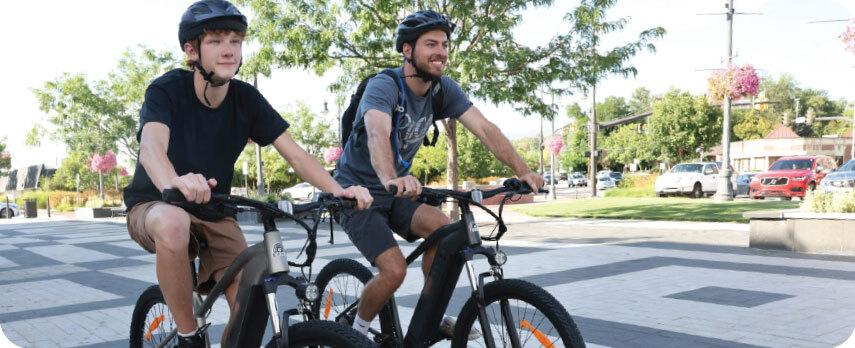E-bike rules of the road
More people are choosing e-bikes as a convenient and accessible mode of clean transportation whether for commuting, running errands or recreation. Find out what classes of e-bikes are allowed in B.C. and how to ride e-bikes safely on the road.

On this page
What are e-bikes?
E-bikes are power-assisted cycles that have a motor to help propel the device. B.C. laws define e-bikes as “motor assisted cycles”, and the Motor Assisted Cycle (E-Bike) Regulation sets rules you must follow to use an e-bike. A person does not need a driver’s license or insurance to operate an e-bike on B.C. roads.
A motor assisted cycle (e-bike) must have:
- Fully operable pedals (or hand cranks) capable of propelling the cycle, including when the motor is engaged and providing assistance propelling the device
- An electric motor of a certain maximum output and no combustion engine
- Safety features that stop the motor from propelling the device in certain instances (e.g. when braking or when not pedaling or applying the throttle)
- Motors and batteries that are securely fastened to the cycle (must have insulated and covered electrical terminals)
- Two or three wheels (must be at least 350mm in diameter)
- A braking system capable of quickly bringing the device to a stop
| Standard e-bike | Light e-bike | |
|---|---|---|
| Minimum rider age | 16 | 14 |
| Maximum motor-assisted speed | 32 km/h | 25 km/h |
| Maximum motor power | 500W | 250W |
| Throttle assist | Yes | No |
A device that does not meet all the requirements of a motor assisted cycle is illegal for use on public roads, or may require a license, registration, and insurance for operation.
Read the Motor Assisted Cycle (E-Bike) Regulation to know the rules.
Riding your e-bike safely
Cyclists (including e-bike riders) must follow the same general road rules as drivers, whether obeying traffic signs and lights, or yielding to pedestrians. Be sure to also follow all these rules when riding an e-bike on a public road.
Be of minimum age: a person under 14 years of age must not ride a light e-bike and a person under 16 years of age must not ride a standard e-bike. Parents or guardians of persons below the minimum age must not knowingly permit them to ride an e-bike.
Wear a safety helmet: always wear an approved safety helmet when riding an e-bike.
Stay to the right: always ride as far right as practicable unless directed elsewhere by a traffic control device. You also cannot ride on sidewalks unless cycle use is permitted by a traffic control device.
Ride single file: do not ride beside another person operating a cycle or e-bike except to pass.
Use hand signals: safely signal intent to turn, slow down, or stop by using standard hand signals.
Use lights and reflectors at night: a white light mounted in the front, a red reflector, and a red light mounted in the rear are required when riding between sunset and sunrise.
Do not ride while impaired or distracted: never operate an e-bike while impaired by alcohol or drugs, or when using a cellphone or other electronic device.
Follow passenger rules: you cannot carry a passenger unless your cycle is designed and equipped for it. A rider under 16 cannot carry any passengers on an e-bike.
These rules are the law. You may receive a $109 fine, have your device impounded or face other penalties of up to $2,000 if you don't follow these safety rules.
Planning a safe trip
New to e-biking? start by reading the user manual and practice riding in a controlled environment to learn how to safely operate your e-bike. If you are renting, follow the instructions provided by the rental company.
Use cycle-friendly routes: bike lanes, shared streets and other low vehicle traffic routes provide a safer and less stressful way to get around on your e-bike. Use them wherever available.
Know the rules where you live: some municipalities set their own rules for where you can ride a cycle and e-bike, including on shared use paths. Check with your municipality to know what rules apply to you.
Connect with public transit: some transit providers (i.e., TransLink, BC Transit) may carry your e-bike. Check with your transit provider for any size or weight restrictions.
Starting June 3, 2024, cyclists (including e-bike riders) have new protections under B.C.’s new vulnerable road user laws, which require drivers to always drive safely around cyclists and give space when passing.
